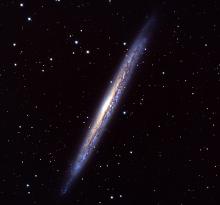Listen to today's episode of StarDate on the web the same day it airs in high-quality streaming audio without any extra ads or announcements. Choose a $8 one-month pass, or listen every day for a year for just $30.
You are here
Lambda Draconis
At the ends of their lives, stars like the Sun do a double dip. They puff up to giant proportions, then shrink, then puff up again, even bigger than the first time.
The star at the end of the tail of Draco, the dragon, is in the midst of that second period of puffing up. It’s about 70 times wider than the Sun, and almost 900 times brighter.
Lambda Draconis is low in the north at nightfall right now, with the rest of the dragon stretching to its left. The star wheels high overhead later on.
Long ago, Lambda Draconis converted the original hydrogen in its core to helium. That caused the core to shrink and get hotter. And that caused the first puffing up, as the star’s outer layers were pushed away from the core. The star then burned the helium to make even heavier elements. So for a while, the star shrank and faded.
Now, though, the core has gotten even smaller and hotter, which is causing the star’s outer layers to puff up even more than the first time.
Before long, though, those layers of gas will begin flying out into space, leaving Lambda Draconis behind. That will surround the dying core with a big, colorful bubble of gas — but only for a little while. Within a few tens of thousands of years, the bubble will dissipate, and only the star’s dead core will remain — a hot but tiny stellar ember known as a white dwarf.
The Sun will go through these phases, too — beginning in about five billion years.
Script by Damond Benningfield




